
Swallowtail butterflies are large, colorful butterflies in the family Papilionidae, and include over 550 species. Though the majority are tropical, members of the family inhabit every continent except Antarctica. The family includes the largest butterflies in the world, the birdwing butterflies of the genus Ornithoptera.
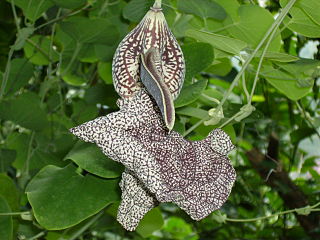
Aristolochia is a large plant genus with over 500 species that is the type genus of the family Aristolochiaceae. Its members are commonly known as birthwort, pipevine or Dutchman's pipe and are widespread and occur in the most diverse climates. Some species, like A. utriformis and A. westlandii, are threatened with extinction.
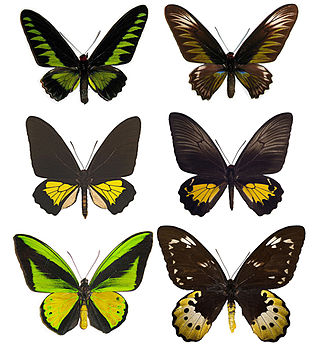
Birdwings are butterflies in the swallowtail family, that belong to the genera Trogonoptera, Troides, and Ornithoptera. Most recent authorities recognise 36 species, however, this is debated, and some authorities include additional genera. Birdwings are named for their exceptional size, angular wings, and birdlike flight. They are found across tropical Asia, mainland and archipelagic Southeast Asia, and Australasia.
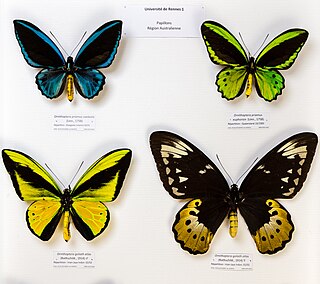
Ornithoptera is a genus of birdwing butterflies found in the northern portion of the Australasian realm, east of Weber's line; the Moluccas, New Guinea, the Solomon Islands, and northeastern Australia; except for Ornithoptera richmondia, which may be found in far northeastern New South Wales, Australia, therefore the southernmost distribution of birdwings. This genus includes the two largest butterfly species in the world, the Queen Alexandra's birdwing and the Goliath birdwing. Ornithoptera species are highly prized by insect collectors because they are rare, large, and considered exceptionally beautiful.

Ornithoptera alexandrae, the Queen Alexandra's birdwing, is the largest species of butterfly in the world, with females reaching wingspans slightly in excess of 25 cm to 28 cm. This birdwing is restricted to the forests of the Oro Province in eastern Papua New Guinea.

Ornithoptera goliath, the Goliath birdwing, is a birdwing butterfly found in New Guinea. It is the second largest butterfly in the world, after the Queen Alexandra's birdwing.

Battus philenor, the pipevine swallowtail or blue swallowtail, is a swallowtail butterfly found in North America and Central America. This butterfly is black with iridescent-blue hindwings. They are found in many different habitats, but are most commonly found in forests. Caterpillars are often black or red, and feed on compatible plants of the genus Aristolochia. They are known for sequestering acids from the plants they feed on in order to defend themselves from predators by being poisonous when consumed. The adults feed on the nectar of a variety of flowers. Some species of Aristolochia are toxic to the larvae, typically tropical varieties. While enthusiasts have led citizen efforts to conserve pipevine swallowtails in their neighborhoods on the West coast, the butterfly has not been the subject of a formal program in conservation or protected in legislation. The butterfly is however of "Special Concern" in Michigan, which is on the Northern limit of its range.

Trogonoptera brookiana, Rajah Brooke's birdwing, is a birdwing butterfly from the rainforests of the Thai-Malay Peninsula, Borneo, Natuna, Sumatra, and various small islands west of Sumatra. The butterfly was named by the naturalist Alfred Russel Wallace in 1855, after James Brooke, the Rajah of Sarawak. The larval host plants are Aristolochia acuminata and A. foveolata. Adults sip flower nectar from plants such as Bauhinia. Rajah Brooke's birdwing is a protected species, listed under Appendix II of CITES, meaning that international export is restricted to those who have been granted a permit. It is the national butterfly of Malaysia.

Rothschild's birdwing is a large birdwing butterfly, endemic to the Arfak Mountains in Western New Guinea.
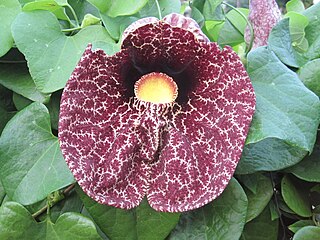
Aristolochia littoralis, the calico flower or مورپنکھ بیل or elegant Dutchman's pipe, is a species of evergreen vine belonging to the family Aristolochiaceae.

The Australian Butterfly Sanctuary is a butterfly sanctuary and exhibit situated in the centre of Kuranda, Queensland, Australia.
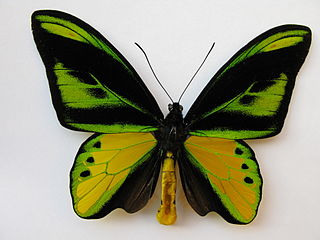
Ornithoptera chimaera, the chimaera birdwing, is a birdwing butterfly of the family Papilionidae. It is found in mountain areas of New Guinea, 1000 meters above sea level.
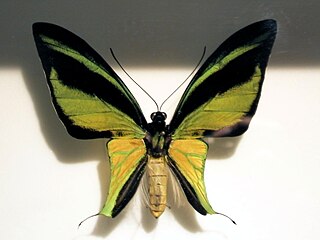
Ornithoptera meridionalis, the southern tailed birdwing, is the smallest species of the genus Ornithoptera. It is known from a handful of localities in southeast Papua, New Guinea and several localities along the south coast of Irian Jaya.

Ornithoptera paradisea, the paradise birdwing, is a species of birdwing butterfly found in New Guinea.

Ornithoptera priamus, the common green birdwing, Cape York birdwing, Priam's birdwing, northern birdwing or New Guinea birdwing is a widespread species of birdwing butterfly found in the central and south Moluccas, New Guinea, Bismarck Archipelago, Solomon Islands, and north-east Australia.
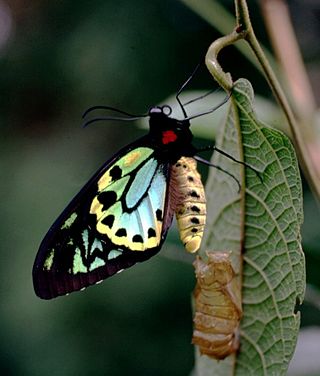
Ornithoptera richmondia, the Richmond birdwing, is a species of birdwing butterfly that is endemic to Australia. It is the second smallest of the birdwing species, the smallest being Ornithoptera meridionalis.

Papilio anactus, the dainty swallowtail, dingy swallowtail or small citrus butterfly is a medium-sized butterfly from the family Papilionidae, that is endemic to Australia.

Aristolochia praevenosa, synonym Pararistolochia praevenosa, is an Australian plant in the birthwort family, native to Queensland and New South Wales. The Richmond birdwing butterfly vine grows in subtropical rainforest in coastal areas north from Wollongbar, in far north eastern New South Wales and adjacent areas in south eastern Queensland. It has been recorded as far north as the Mary River. It also grows in tropical north eastern Queensland, where it is a food plant for the Cairns birdwing butterfly.

Troides amphrysus, the Malay birdwing, is a birdwing butterfly in the genus Troides in the family Papilionidae.

Austrocallerya megasperma, one of several species commonly known as native wisteria, is a species of flowering plant in the family Fabaceae and is endemic to eastern Australia. It is a woody climber with pinnate leaves and racemes of purple, pea-like flowers.



























